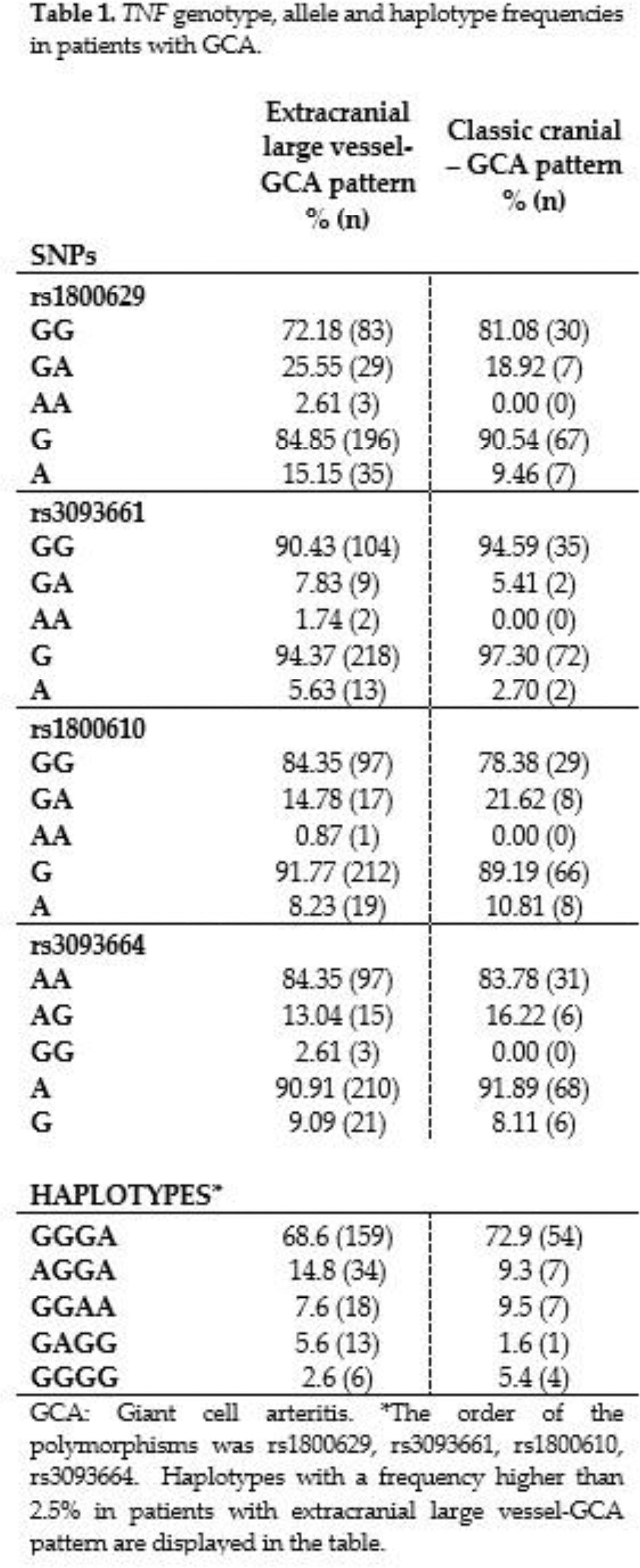

Background: Giant cell arteritis (GCA) is the most common vasculitis in people over 50 in Western countries [1]. Currently, two distinct phenotypes of the disease can be identified based on the presence of predominant cranial or extracranial manifestations [1]. However, the mechanisms underlying these two phenotypes are poorly understood. Interestingly, previous studies have shown that GCA patients with a strong systemic inflammatory response had elevated tissue expression of proinflammatory cytokines, particularly tumor necrosis factor (TNF) alpha, and that high production of this molecule was associated with prolonged corticosteroid requirements [2]. Moreover, an association between elevated tissue TNF alpha concentrations and disease activity has been described [3]. Therefore, given that there is increasing attention on genetic polymorphisms as disease biomarkers, it is plausible to think that TNF could be relevant in the phenotypic expression of GCA.
Objectives: To determine whether TNF polymorphisms may be useful as biomarkers for differential diagnosis between extracranial and cranial large vessel vasculitis phenotypes in GCA patients.
Methods: A total of 152 Caucasian patients diagnosed with GCA, 115 with extracranial large-vessel GCA who had no cranial ischaemic manifestations of GCA, and 37 with biopsy-proven GCA who had typical cranial manifestations of the disease, were included in the present study. Four single-nucleotide polymorphisms within the TNF gene (rs1800629, rs3093661, rs1800610, rs3093664) were genotyped in all the patients with GCA using TaqMan probes.
Results: No statistically significant differences were found in the genotype and allele frequencies of the four TNF polymorphisms evaluated when patients with extracranial and cranial phenotypes were compared (Table 1). In addition, patients with extracranial large vessel pattern and those with classic cranial pattern were similar in terms of the haplotype frequencies of TNF (Table 1).
Conclusion: Our results show that the studied polymorphisms in TNF do not seem to influence the phenotypic expression of GCA, not constituting biomarkers of differential diagnosis between patients with extracranial and cranial manifestations.
REFERENCES: [1] Rheumatology (Oxford). 2017 Apr 1;56(4):506-515.
[2] Rheumatology (Oxford). 2004 Mar;43(3):294-301.
[3] Rheumatology (Oxford). 2011 Nov;50(11):2061-70.

Acknowledgements: VP-C is supported by funds of NVAL23/02 from IDIVAL; RL-M is a recipient of a Miguel Servet type II program fellowship from the ISCIII, co-funded by ESF (“Investing in your future”) (CPII21/00004); JCB-L is a recipient of a PFIS program fellowship from the ISCIII, co-funded by the European Social Fund (‘Investing in your future’), (FI22/00020). The research has also been made possible thanks to the Aid for research projects without public funding for emerging researchers (Spanish Rheumatology Foundation 2023).
Disclosure of Interests: Verónica Pulito-Cueto Boehringer Ingelheim, Raquel López-Mejías: None declared. Joao Carlos Batista-Liz: None declared. Javier Loricera: None declared. Diana Prieto-Peña: None declared. Alejandro Muñoz Jimenez.: None declared. Francisco Ortiz-SanJuan: None declared. Susana Romero-Juste: None declared. Clara Moriano Morales: None declared. Eva Galíndez-Agirregoikoa: None declared. Noelia Alvarez-Rivas: None declared. Santos Castañeda: None declared. Ricardo Blanco had consultation fees/participation in company-sponsored speaker´s bureau from Abbvie, Pfizer, Roche, Bristol-Myers, Lilly, Janssen, and MSD, has received grants/research supports from Abbvie, MSD, and Roche.
© The Authors 2025. This abstract is an open access article published in Annals of Rheumatic Diseases under the CC BY-NC-ND license (